Man complains of decreased vision on routine exam
The right macula had a gravity-dependent serous detachment tracking inferiorly with associated RPE changes.
A 37-year-old hyperopic man, originally from Lima, Peru, presented to the New England Eye Center for a routine eye exam. He complained of decreased vision, greater in the right eye than the left, in the past couple of months. The patient had no other relevant ocular history. His medical history was significant for cold sores and “herpetic rashes.” He was not currently taking any medications.
Examination
Best corrected visual acuity was 20/60+2 in the right eye and 20/20 in the left eye. Pupils were equal and reactive with no relative afferent pupillary defect. IOP measured 14 mm Hg in the right eye and 15 mm Hg in the left eye. Extraocular movements and confrontation visual fields were full. The anterior segment exam was unremarkable.
On dilated funduscopic exam, 1+ pigmented cells were seen in the anterior vitreous of the right eye. The right macula had an extensive gravity-dependent serous detachment tracking inferiorly with associated retinal pigment epithelium (RPE) changes. Neovascularization, aneurysmal changes, sclerotic vessels and exudates along the peripheral vessels were also seen in the inferior far periphery. A healed operculated hole was noted inferotemporally with an attached retina. (Figure 1). Fluorescein angiography of the periphery showed leakage in the area of neovascularization and aneurysm, with adjacent ischemic changes in the right eye (Figure 2). RPE changes were seen in the left macula.
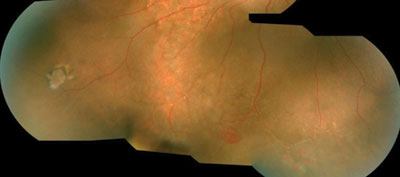
Figure 1. Fundus photograph of the right eye. Neovascularization, aneurysms, sclerosis and exudates are present in the periphery. A healed operculated hole is also noted.
Source: Vuong LN, Goldman DR, Rogers AH

Figure 2. Fluorescein angiography of the right eye. Leakage is present in the area of neovascularization, as well as aneurysms with adjacent ischemic changes.
What is your diagnosis?
Vascular changes
Given the patient’s prominent vascular changes, our differential diagnosis included venous occlusive disease, sickle cell retinopathy, Coats’ disease, diabetic retinopathy and Takayasu’s retinopathy. Inflammatory processes such as Eales’ disease, Harada’s disease, sarcoidosis and Behçet’s disease were also considered. With the patient’s history of cold sores and herpetic rashes, there was also suspicion for viral infection leading to acute retinal necrosis. A chronic rhegmatogenous retinal detachment was ruled out by the absence of a retinal tear.
Diagnosis
Subretinal fluid was seen in the right macula upon close examination, which was confirmed by Cirrus OCT (Carl Zeiss Meditec) (Figure 3). Fluorescein angiography revealed a focal area of leakage or “hot spot” temporal to the macula (Figure 4). The patient was diagnosed with chronic central serous chorioretinopathy (CSCR) associated with extensive gravity-dependent retinal detachment, RPE changes and peripheral neovascularization.
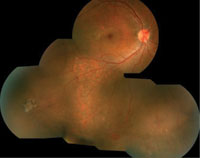

Figure 3. Fundus photograph and macular OCT of the right eye. Subretinal fluid is seen in the macula, along with an inferior gravity-dependent serous detachment and RPE changes. OCT further demonstrates the presence of subretinal fluid.
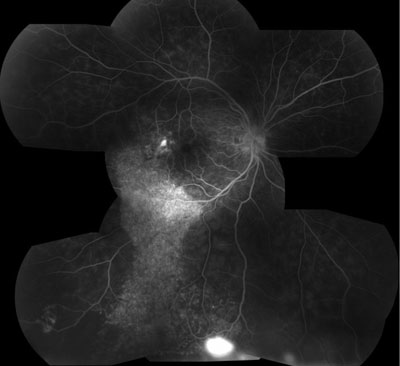
Figure 4. Fluorescein angiography of the right eye. A focal area of leakage temporal to the macula with a tract of RPE changes extending to the periphery highlights the gravity-dependent nature of this patient’s serous retinal detachment.
Discussion and treatment
CSCR is an idiopathic disease characterized by focal or multifocal leakages at the level of the RPE resulting in serous detachment of the neurosensory retina at or near the macula. The findings are usually unilateral or asymmetric in presentation. CSCR commonly occurs in men between the ages of 30 and 50 years with “type A” personality and has been associated with elevated corticosteroid levels. A majority of patients will have spontaneous resolution of their symptoms with no permanent vision loss; however, roughly 40% to 50% of these patients will experience a recurrence. Permanent vision loss is uncommon, occurring in only 5% to 10% of patients due to recurrent or chronic CSCR.
Subretinal fluid due to CSCR most commonly accumulates in the macula, but chronic CSCR can lead to peripheral serous retinal detachments by fluid extending inferiorly via gravitational tracts. Occasionally, neovascularization and aneurysmal changes can be found at the inferior edge of chronic detachments, as demonstrated in our patient’s case. Serous retinal detachments are thought to extend inferiorly due to both gravity and retinal toxicity from long-standing subretinal fluid. This extension of fluid is thought to promote resorption by involving a larger surface area.
A majority of CSCR cases will spontaneously resolve over 3 to 4 months followed by varying degrees of visual recovery. Laser photocoagulation or photodynamic therapy is reserved for serous detachments persisting beyond 4 months, recurrence with prior visual changes, vision deficits in the fellow eye from prior CSCR, retinal cystic changes, widespread RPE abnormalities, and occupational necessity. PDT is now used more often, especially in cases in which the leakage site is close to the macula. PDT has a direct effect on choroidal circulation and causes less retinal damage/ischemia. In contrast to patients treated with PDT for wet age-related macular degeneration, PDT for CSCR is used with either half fluence or half duration.
In chronic CSCR with large areas of involvement, treatment with either PDT or laser photocoagulation can lead to good resolution of associated retinal detachments and/or vascular changes. Our patient was treated with PDT using a spot size 1,000 µm greater than the lesion, using full fluence (600 mW/cm2) and half time, for a total duration of 40 seconds. At 4-week follow-up, the patient’s BCVA improved slightly to 20/50 in the right eye, while his peripheral serous retinal detachment and neovascularization had completely resolved (Figures 5a and 5b). OCT demonstrated a diminished photoreceptor layer, likely a result of long-standing subretinal fluid and responsible for only minimal improvement in visual acuity (Figure 6).
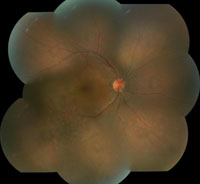
Figure 5a. Fundus photograph of the right eye. Subretinal fluid and peripheral vascular changes have resolved 4 weeks after PDT treatment.
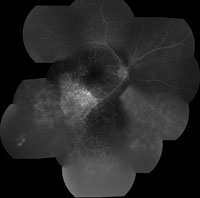
Figure 5b. Fluorescein angiography of the right eye. No focal areas of leakage or peripheral neovascularization persist 4 weeks after PDT treatment.
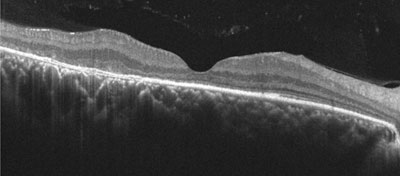
Figure 6. Macular OCT of the right eye. Resolution of subretinal fluid 4 weeks after PDT treatment. Thinning of the outer retinal layers, including the photoreceptor layer, is present.
Summary
Chronic central serous chorioretinopathy can present with large serous retinal detachments due to gravitational tracts of fluid extending beyond the macula. Retinal pigment epithelium changes also occur in areas of chronic detachment. Only in rare cases are neovascularization and ischemia present. Treatment of leakage areas or hot spots within the choriocapillaris may lead to resolution.
References:
- Akiyama K, Kawamura M, Ogata T, Tanaka E. Retinal vascular loss in idiopathic central serous chorioretinopathy with bullous retinal detachment. Ophthalmology. 1987;94(12):1605-1609.
- Barbazetto IA, Cinquini M, Takahashi BS, Yannuzzi LA. Central serous chorioretinopathy and peripheral retinal neovascularization. Retinal Cases & Brief Reports. 2009;3(2):224-227.
- Chan WM, Lam DS, Lai TY, Tam BS, Liu DT, Chan CK. Choroidal vascular remodelling in central serous chorioretinopathy after indocyanine green guided photodynamic therapy with verteporfin: a novel treatment at the primary disease level. Br J Ophthalmol. 2003;87(12):1453-1458.
- Chan WM, Liu DT, Chan CK, Wong BW, Tam PM, Lam DS. Peripheral retinal neovascularization in bullous central serous chorioretinopathy. Eye (Lond). 2004;18(12):1275-1277.
- Ober MD, Yannuzzi LA, Do DV, et al. Photodynamic therapy for focal retinal pigment epithelial leaks secondary to central serous chorioretinopathy. Ophthalmology. 2005;112(12):2008-2094.
- Reibaldi M, Boscia F, Avitabile T, et al. Functional retinal changes measured by microperimetry in standard-fluence vs low-fluence photodynamic therapy in chronic central serous chorioretinopathy. Am J Ophthalmol. 2011;151(6):953-960.
- Taban M, Boyer DS, Thomas EL, Taban M. Chronic central serous chorioretinopathy: photodynamic therapy. Am J Ophthalmol. 2004;137(6):1073-180.
- von Winning CH, Oosterhuis JA, Renger-van Dijk AH, Hornstra-Limburg H, Polak BC. Diffuse retinal pigment epitheliopathy. Ophthalmologica. 1982;185(1):7-14.
- Yannuzzi LA. Non-rhegmatogenous retinal detachment. In: The Retinal Atlas. Philadelphia: Saunders Elsevier; 2010:Chapter 10.
- Yannuzzi LA, Shakin JL, Fisher YL, Altomonte MA. Peripheral retinal detachments and retinal pigment epithelial atrophic tracts secondary to central serous pigment epitheliopathy. Ophthalmology. 1984;91(12):1554-1572.
- Yannuzzi LA, Slakter JS, Gross NE, et al. Indocyanine green angiography-guided photodynamic therapy for treatment of chronic central serous chorioretinopathy: a pilot study. Retina. 2003;23(3):288-298.
For more information:
- Laurel N. Vuong, MD, Darin R. Goldman, MD, and Adam H. Rogers, MD, can be reached at New England Eye Center, Tufts University School of Medicine, 750 Washington St., Box 450, Boston, MA 02111; 617-636-4219; fax: 617-636-4866; website: www.neec.com.
- Edited by Catherine A. Cox, MD, and Jordana F. Goren MD, MS. Drs. Cox and Goren can be reached at New England Eye Center, Tufts University School of Medicine, 750 Washington St., Box 450, Boston, MA 02111; 617-636-4219; fax: 617-636-4866; website: www.neec.com.









